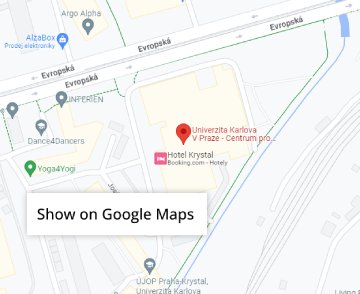Prague, the capital of the Czech Republic, is our most valuable historical city reserve. In 1992 the historical core of the city covering 866 hectares was listed in the UNESCO World Cultural and Natural Heritage Register.
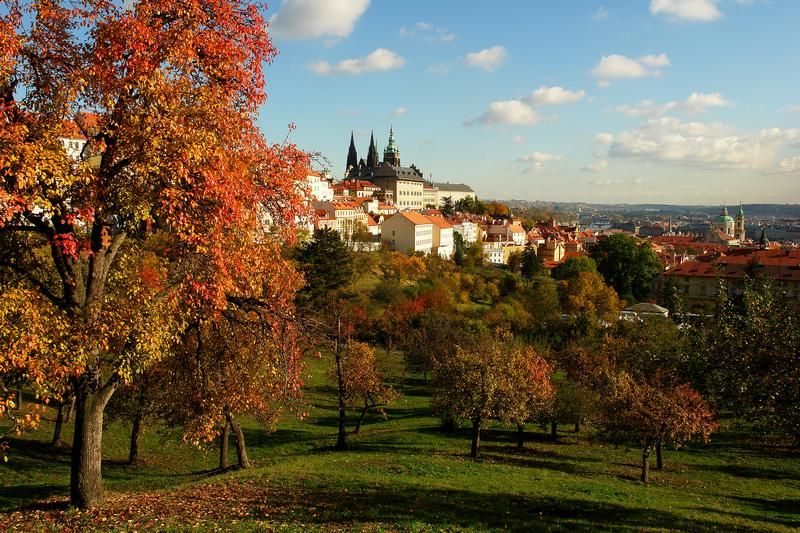
Prague represents a unique collection of historical monuments dominated by the Prague Castle which towers high above the city. It is a display of all artistic styles and movements. The historical core of the city is situated on both banks of the Vltava river and consists of 6 parts - formerly independent urban units unified in the 18th century. They are as follows: Stare Mesto (Old Town), Josefov (the preserved part of the former Jewish Town - today a part of the Old Town), Nove Mesto (New Town), Mala Strana (Lesser Town), Hradcany and Vysehrad. Naturally, most of the historical monuments, museums and galleries are concentrated right there.
The centre of Prague is characterised by winding alleys and constructions of all architectural styles - Romanesque rotundas, Gothic cathedrals, Baroque and Renaissance palaces, Art Nouveau, Classicist, Cubist and Functionalist houses and modern buildings.
Prague in numbers
|
Area |
496 sqkm |
|
Population |
1 250 000 (31. 3. 2010) |
|
Geographical situation |
north latitude 50° 05', east longitude 14° 27', height above sea level 235 m (average) |
|
Time |
Central European (GMT+1), summer time - Central European +1 (GMT+2) |
|
Climate |
average temperature 9,0°C |
|
Main river |
The Vltava river flows through the city in the length of 30 km, its maximum width being 330 m |
|
Electric voltage |
230 V |
|
Parts of the historical centre |
Hradcany, Mala Strana (Lesser Town), Stare Mesto (Old Town) including Josefov, Nove Mesto (New Town) and Vysehrad |
|
Administrative division |
22 administrative areas |
Prague monuments
The Prague castle
 National cultural monument, the symbol of more than millennial development of the Czech state. Since its foundation in the last quarter of the 9th century it has been developing uninterruptedly throughout the past eleven centuries. It is a monumental complex of ecclesiastical, fortification, residential and office buildings representing all architectural styles and periods, surrounding three castle courtyards and covering 45 hectares. Originally it used to be the residence of princes and kings of Bohemia, since 1918 it is the seat of the president.
National cultural monument, the symbol of more than millennial development of the Czech state. Since its foundation in the last quarter of the 9th century it has been developing uninterruptedly throughout the past eleven centuries. It is a monumental complex of ecclesiastical, fortification, residential and office buildings representing all architectural styles and periods, surrounding three castle courtyards and covering 45 hectares. Originally it used to be the residence of princes and kings of Bohemia, since 1918 it is the seat of the president.
St. Vitus, St. Wenceslas and St. Adalbert Cathedral is A gothic cathedral, the spiritual symbol of the Czech state, founded in the year 1344 by Jan Lucembursky (John of Luxembourg) and his sons Karel (Charles) and Jan Jindrich (John Henry) in the place of the original romanesque rotunda. The construction proceeded according to the plans of Matthias of Arras (until 1352), and then Petr Parler (1356 - 1399). The construction period protracted to nearly 600 years and it was finally completed in 1929. Decorated by precious works of art it encloses St. Wenceslas' Chapel and the Crypt with tombs of Bohemian kings. The coronation jewels are deposited here, too.
Charles Bridge and bridge Towers
The oldest Prague bridge built in the place of the Judita's Bridge that had been badly damaged by a flood in 1342. The Stone or Prague Bridge since 1870 called Charles Bridge, was founded by Charles IV in the year 1357. By the latest researches the construction was started by Master Otto and finished by Peter Parler in 1402. Both ends of the bridge are fortified by towers (the Lesser Town Bridge Towers, the Old Town Bridge Tower). From 1683 to 1928 thirty sculptures and sculptural groups of the saints were gradually set on the bridge piers (M. Braun, F. M. Brokof, etc.) The bridge is 515 meters long and 10 meters wide.
The smaller tower - the romanesque one, a relic of the Judita's Bridge, was constructed in the 12th century. The higher one is 200 years younger (1464) and its late gothis architecture draws upon the Parler's Old Town Bridge Tower.
The entrance gate to the Charles Bridge from the Old Town river bank, the most beautiful gate of the Gothic Europe was a masterpiece of the Court Buildingworks, it was finished before 1380. It is richly adorned with sculptures - coats of arms of the countries belonging to the Czech Crown under the reign of Charles IV, statues of St. Vitus, Charles IV, Wenceslas IV, St. Vojtech (Adalbert) and Sigmund.
Old Town Hall with the Astronomical Clock
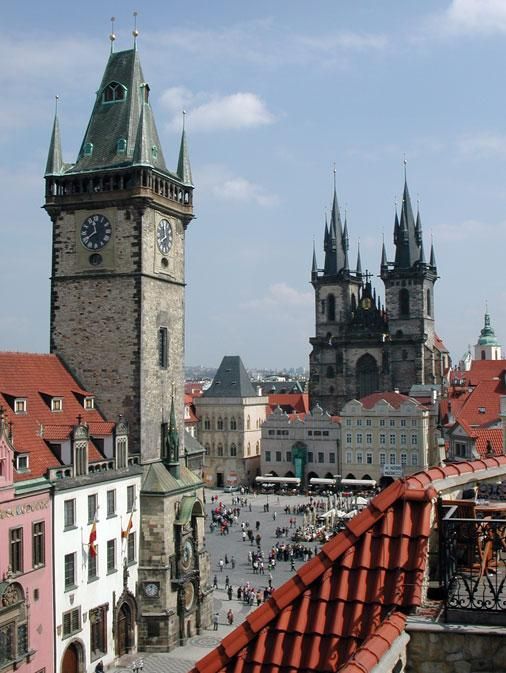 Established 1338 as the seat of the Old Town authorities. The oldest gothic part of the complex which includes a tower and an oriel chapel is richly decorated with coats of arms. It was built in the latter half of the 14th century. In the top part of the astronomical clock (early 15th century) the 12 apostles appear every hour between 9 a.m. and 9 p.m The bottom part was supplemented with a round calendarium including the signs of the zodiac painted by Josef Manes (1865). The eastern pseudo-gothic wing of the Town Hall was destroyed on May 8, 1945, and has not been rebuilt yet.
Established 1338 as the seat of the Old Town authorities. The oldest gothic part of the complex which includes a tower and an oriel chapel is richly decorated with coats of arms. It was built in the latter half of the 14th century. In the top part of the astronomical clock (early 15th century) the 12 apostles appear every hour between 9 a.m. and 9 p.m The bottom part was supplemented with a round calendarium including the signs of the zodiac painted by Josef Manes (1865). The eastern pseudo-gothic wing of the Town Hall was destroyed on May 8, 1945, and has not been rebuilt yet.
Josefov - Prague Ghetto
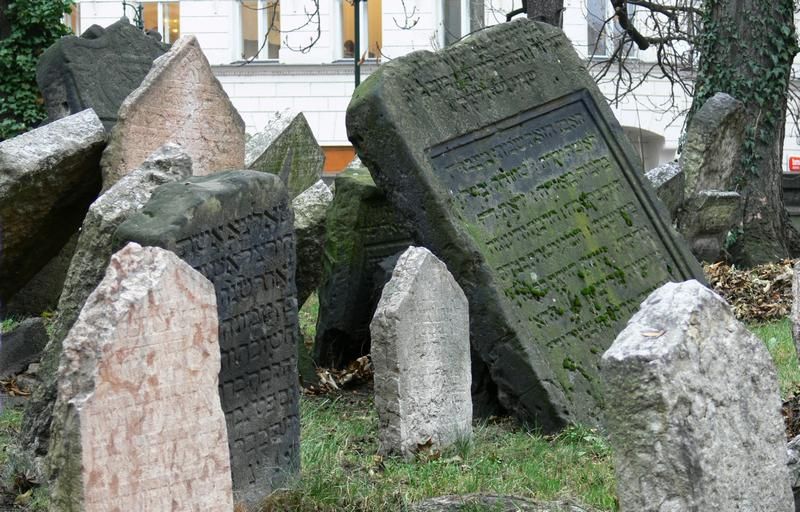 It dates back to the 13th century but its present appearance is mainly the result of a vast redevelopment action undertaken between 1893 - 1913. Only a few most significant buildings were saved, the living testimony of the history of Prague Jews which lasted for many centuries. Yet these buildings form the best present complex of Jewish historical monuments in the whole Europe.Six synagogues remain from this old settlement which includes the Jewish Town Hall and the Old Jewish Cemetery - the most remarkable in Europe. Except the Old-New Synagogue they are part of the Jewish Museum.
It dates back to the 13th century but its present appearance is mainly the result of a vast redevelopment action undertaken between 1893 - 1913. Only a few most significant buildings were saved, the living testimony of the history of Prague Jews which lasted for many centuries. Yet these buildings form the best present complex of Jewish historical monuments in the whole Europe.Six synagogues remain from this old settlement which includes the Jewish Town Hall and the Old Jewish Cemetery - the most remarkable in Europe. Except the Old-New Synagogue they are part of the Jewish Museum.
Old-New Synagogue is the oldest preserved synagogue in the Central Europe. It was built in the early gothic style in the late 13th century and richly adorned by stonework. Also the inside furnishings (gothic wrought-iron grill, wrought chandeliers) are of ancient origin. Up till now it has served as a house of prayer and the main synagogue of the Prague Jewish community.
Old Jewish Cemetery - Jewish Museum has been established in the mid-15th century it served as a burial site till 1787. Among 12 000 gothic, renaisance and baroque tombstones are also those of Rabbi Jehuda Löw (1609) and Mordechai Maisel (1601).
Powder Tower
A monumental entrance to the Old Town built by Matej Rejsek in the gothic style in 1475. Once it served as a gunpowder depot. In the late 19th century it was rebuilt by J. Mocker.
St. Nicolas Church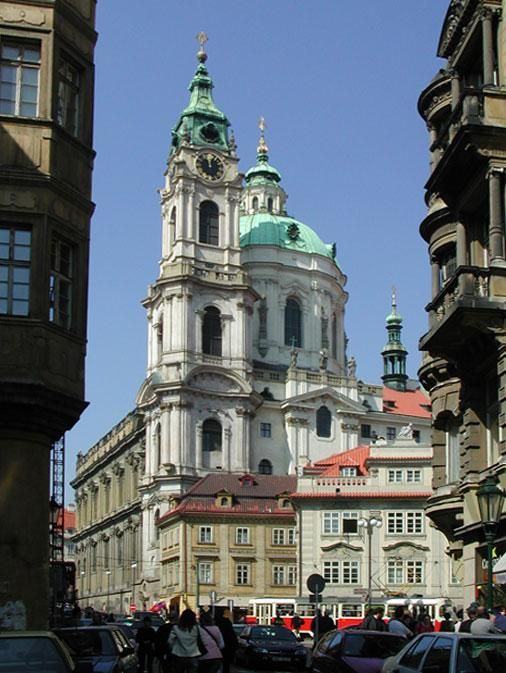
One of the most valuable buildings of the "Prague Baroque" period with a dominant dome and the belfry (architects K. Dienzenhofer, K. I. Dienzenhofer, A. Lurago, 1704 - 1756). Also the inside decoration of the church is a specimen of the high baroque style (J. L. Kracker, K. Skreta). W. A. Mozart played the organ here during his stay in Prague. Permanent exhibition: Prague Bells
Petrin View Tower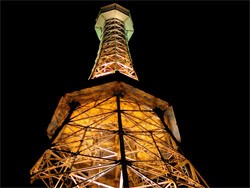
Reduced copy of the Eiffel Tower (60 m high) built in 1891 on the occasion of the Jubilee Exhibition. 299 steps lead up to the top platform. In March 2002 the Tower was opened again to the public after a wide reconstruction.
Loreta
 A Marian pilgrimage place with a copy of the Italian Santa Casa (G. Orsi, 1626 - 1627) including also the baroque Church of the Nativity of Our Lord (K. I. Dienzenhofer, 1734 - 1735). The ground is encircled by a cloister and chapels. The spire houses a carillon which consist of 27 Loreta bells which tune a Marian song We Greet You a Thousand Times (every hour from 9 a.m. to 6 p.m.). The most valuable item of the liturgical treasury is the so-called Loreta Treasure, a collection of sacral object from the 16th to 18th centuries. The most famous of these is the Diamond Monstrance adorned with 6 222 diamonds.
A Marian pilgrimage place with a copy of the Italian Santa Casa (G. Orsi, 1626 - 1627) including also the baroque Church of the Nativity of Our Lord (K. I. Dienzenhofer, 1734 - 1735). The ground is encircled by a cloister and chapels. The spire houses a carillon which consist of 27 Loreta bells which tune a Marian song We Greet You a Thousand Times (every hour from 9 a.m. to 6 p.m.). The most valuable item of the liturgical treasury is the so-called Loreta Treasure, a collection of sacral object from the 16th to 18th centuries. The most famous of these is the Diamond Monstrance adorned with 6 222 diamonds.
Vysehrad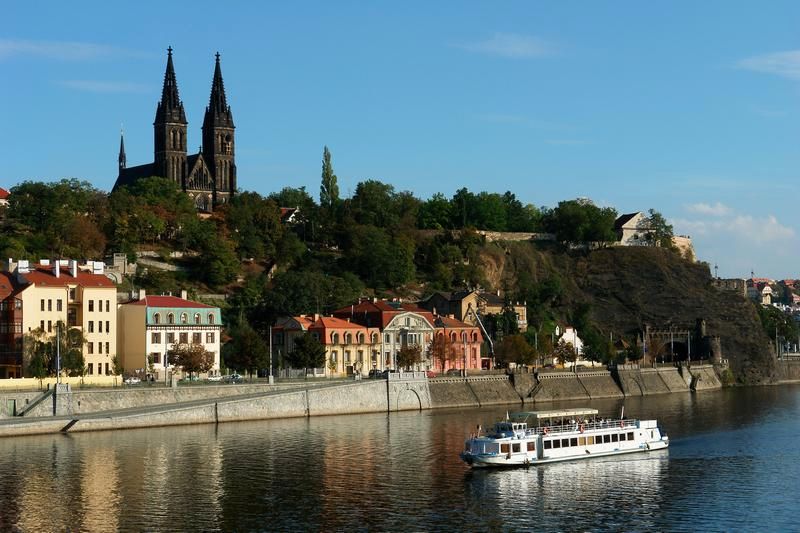
Ancient legends situate the original seat of the Czech princes - the legendary Princess Libuse and the first Przemyslides - on the hill. In fact, however, this fort had not been founded until the Prague Castle was already in existence, since it dates back to the mid-10th century. In the latter half of the 11th and in the 12th century Vysehrad used to be the Przemyslides princes' main residence which brought about a generous building activity within its walls. Among noteworthy sight there are the precious romanesque rotunda of St. Martin (interior only for groups announced in advance), the gothic church of St. Peter and Paul (in the late 19th century rebuilt in the neogothic style), the Vysehrad cemetery used as a burial site of the Czech outstanding personalilties since 1869 with a collective tomb called Slavin, the underground casemates housing the originals of several baroque statues from the Charles Bridge. The Vysehrad site is open the whole day.
For more information about Prague please visit http://www.praguewelcome.cz
About Czech Republic
The Czech Republic is an important tourist destination. It offers visitors not only a multitude of historical landmarks but also diverse natural sites: mountains, ponds, caves and spas with mineral springs. The capital city of Prague is one of the most beautiful cities in the world, with unforgettable atmosphere of a metropolis whose history spans a millennium. Other regions of the country, not just the capital, also offer countless museums, galleries and landmarks.
From the moment visitors cross the borders they enter a varied natural environment with changing landscape and many historic cities and towns, distinctive villages with beautiful folk architecture, numerous recently reconstructed chateaux, old castles and churches. They can also visit the impenetrable virgin forest in the Šumava Mountains, or the harsh Giant Mountains (Krkonoše) and Ore Mountains (Krušné hory). Rock climbers will enjoy the popular Prachovské skály and Bohemian Switzerland (České Švýcarsko) with their sandstone cities and numerous karst areas and caves. The south Bohemian landscape with hundreds of lakes and the south Moravian region renowned for cultivating excellent wines are also popular.
The Czech Republic and its capital offer many protected cultural monuments, cities and villages. Some of them are on the UNESCO list of world cultural and natural heritage sites: in addition to Prague's historic centre, there are also Český Krumlov, Telč, Kutná Hora, the pilgrimage church of Saint John Nepomuk at Zelená hora, the Lednice-Valtice cultural landscape, the gardens and castle in Kroměříž, the south Bohemian village of Holašovice, Litomyšl - Renaissance castle and historic city centre, Olomouc - Holy Trinity Column, Brno - villa Tugendhat, Třebíč - Jewish Quarter and St Procopius' Basilica.
| Population: | 10,515,818 |
|
| Population density: | 133 people per square km | |
| Nationalities: | 81.1% Czech, 13.2% Moravian, 0.4% Silesian (totalling 94.7%), 0.5% German, 3.1% Slovak, 0.3% Romanies, 0.6% Polish, 0.2% other. | |
| Total area: | 78,866 square km |
The Czech Republic is situated in Central Europe. It lies between 48 degrees, 33 minutes, 9 seconds and 51 degrees, 3 minutes and 22 seconds in the northern latitude and between 12 degrees, 5 minutes, 33 seconds and 18 degrees, 51 minutes, 40 seconds in the eastern longitude. The country's longest distance from east to west is 493 km, and its longest distance from north to south is 278 km. In terms of size, the Czech Republic is 21st in Europe, smaller than Hungary, Portugal and Austria but larger than Ireland, Lithuania and Latvia. The Czech Republic shares its borders with Germany, Austria, Slovakia and Poland. Its average elevation above sea level is 430 metres.
For more information visit: www.czechtourism.com



